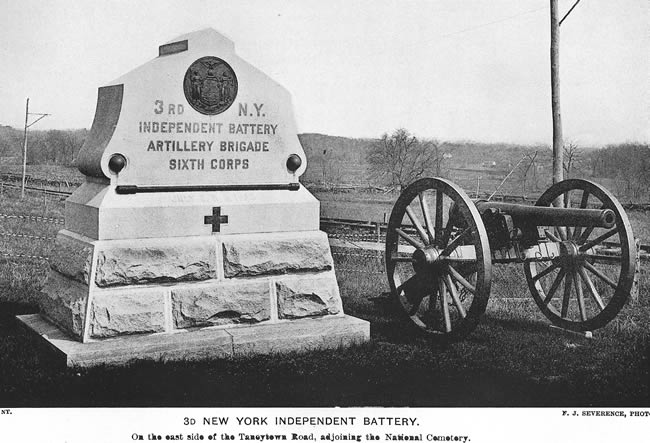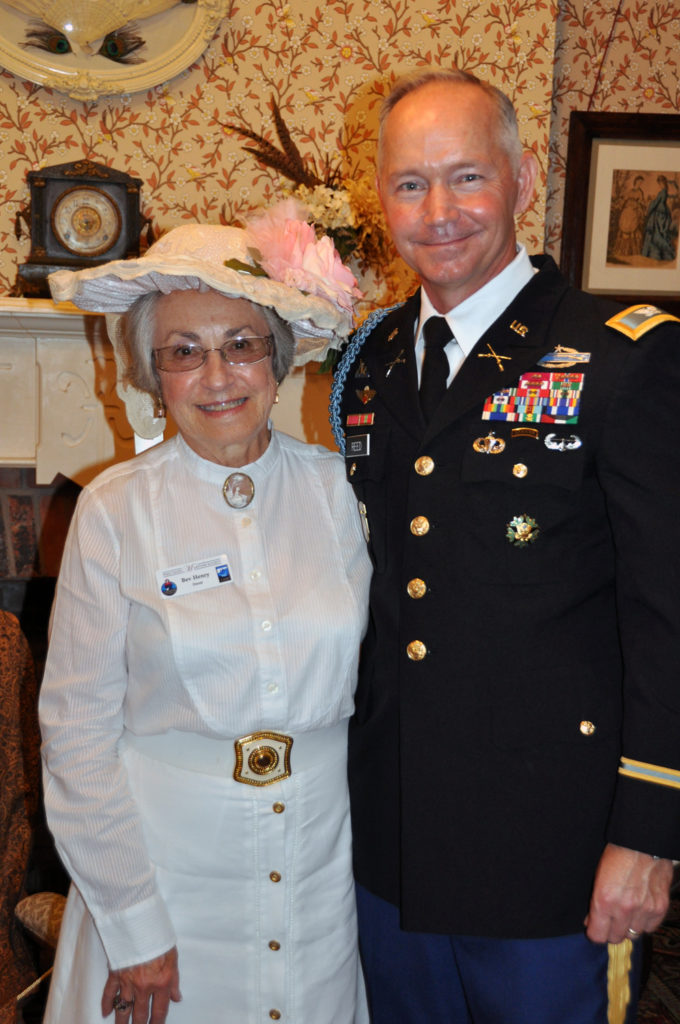Who were the Harns?
In our new interactive exhibit, At Home with the Harns, you can experience life as it was for Head Keeper William Harn and his family. Harn served at the St. Augustine Light Station from 1875-1889 where he and his family were the first residents of the Victorian Keepers’ House.
But who were the Harns? How did they come to be in St. Augustine?
William & Kate’s Marriage
St. Augustine Lighthouse Keeper, Brevet Major William Harn of Philadelphia, enlisted in the United States Army in 1854 at the age of 19.
Some years later, as a private, he was sent to Fort Moultrie, S.C., where he met the daughter of Ordnance Sergeant James Skillen. Her name was Kate.
Harn was transferred to Fort Sumter, S.C., where he was when the Confederate Bombardment occurred and the Civil War began. He and Kate were married in Rome, New York, at the Rome Arsenal on June 2, 1863. He was 28 and she was 19.
Harn and the Battle of Gettysburg
 After a 10 day furlough for this “very important personal business,” on June 5th he marched with the 3rd NY Independent Battery, as part of the VI Corps toward Gettysburg, PA. He arrived there on the 2nd day of the battle bringing 119 men and six 10 pounder parrot rifles. He had held command of the Battery for less than a month, having been promoted in June.
After a 10 day furlough for this “very important personal business,” on June 5th he marched with the 3rd NY Independent Battery, as part of the VI Corps toward Gettysburg, PA. He arrived there on the 2nd day of the battle bringing 119 men and six 10 pounder parrot rifles. He had held command of the Battery for less than a month, having been promoted in June.
Harn’s team saw action however, only after the battle, as the Confederates began to retreat. A few days later Harn’s battery engaged Major General Jeb Stuart’s Calvary at Funkstown, Maryland. Stuart’s cavalry-men were determined to protect the retreat of Robert E Lee’s Army into Virginia after the loss at Gettysburg. The day long battle saw 479 casualties. Captain Harn then ferried his guns across the Potomac River and participated at the battle of Rappahannock Station, VA where Lee’s army faced a humiliating loss with over 1600 captured.
Harn falls ill, faces Civil War’s most difficult battles
In May of 1864 after contracting malarial fever and taking sick leave the year before, Harn was at the Battle of Spotsylvania where some 30,000 casualties occurred. The death of Major General James Sedgwick under whom Harn served in the VI Corps, is one of the most notable of the conflict, as he was killed by a sharpshooter while chiding his men to stop dodging bullets because the Confederates “couldn’t hit an elephant at this distance.” During this conflict some of the most difficult hand to hand combat of the war occurred.
Harn’s battery participated in the trench warfare at Cold Harbor under brutal conditions. The next day after the battle, Harn along with the VI Corps left in route to Petersburg, VA. The series of battles around Petersburg lagged from June 9, 1864 – March 25, 1865. Harn was promoted to Brevet (an honorary title given for bravery) Major in the 3rd NY Independent Battery on August 1, 1864 during the Petersburg campaign.
The final throes of battle
On August 2, Harn left Fort Urmstron at Petersburg and participated in the pursuit of Lee’s Army. On April 6th, 1865 he was in the Battle of Saylor’s Creek, VA, one of the last skirmishes of the war. Here nearly on fourth of the retreating Confederate Army was cut off by portion of the II Corps and the VI Corps (Harn’s). Two confederate divisions led by MGEN Custis Lee and Joseph B. Kershaw, under the command of Lt. Gen Richard B. Ewell fought the VI corps along the creek. Harn’s VI Corps attacked after an artillery bombardment. The Confederates counter attacked but were driven back at the last. Soon afterwards the Union cavalry cut through the right of the Confederate lines. Most Confederates surrendered including nine Generals Ewell and Kershaw included.
Harn was at the surrender of Robert E. Lee at Appomattox Court House, just as he had been at Fort Sumter when the war began, making him one of the very few solders to see both. He would now have time for a personal life, although he had contracted tuberculosis at some point and remained sick throughout the rest of his life to some degree.
Starting a new life Post-Civil War
Brevet Major William Harn was 5 feet 5 inches tall with grey eyes and brown hair. In August of 1865 he and his wife moved to Charleston, S.C. where he lived as a merchant until September of 1869. He served as a lighthouse keeper in Charleston from October 1871-75 and was transferred to be the principle keeper at St. Augustine Lighthouse on Anastasia Island, a post he held until his death of consumption on May 31, 1889.
The Harns’ first daughter, Ruby Isabel, was born November 10 in Rome, N.Y. The second daughter, Mollie E., was born in 1867 in Charleston. Ida Birden Harn was born March 16, 1873, also in Charleston. The Harns’ fourth daughter was named after her mother, Kate. She was probably born in St. Augustine around 1878. Grace Edna Harn was born March 4, 1882, at the Keeper’s House in St. Augustine. (Source Jan Reed, handwritten letter to the Pension Board, 2011.)
Harn was well paid as a lighthouse keeper’s with a salary of $720 per year. The labor value of that commodity today is about $102,000.00 (source), though its actual purchasing power may be much less than that, and its economic power much higher.
It is safe to say that the Harns were a firmly middle class family with some income given that the Government also provided housing.
In lighthouse records, a doctor’s notice (before Harn dies) said that he was in such a weakened state with tuberculosis, that Kate must’ve been doing his work for about a year before he dies.
After William’s death, Kate became second assistant keeper for a time with a salary of $400 a year. She did not hold this position long, and moved back to Maine shortly thereafter.
The Keepers’ House during William & Kate’s Time
Because the Keeper’s House was burned in 1970 and then restored by the Junior Service League over 15 years, we have no documentary evidence of the interiors. We know from the United States Lighthouse Keepers Manuals that wallpaper in keepers’ dwellings was not against regulation until the very end of the 19th century/beginning of the 20th century. And we know that Victorian lighthouse keepers were of higher social status than their WWII counterparts.
After Harn’s death we know that the entire house was re-plastered by the Federal Government, and never papered again. The patterns and carpets and objects in the house you will see are not original, but reflect the style prevalent in Maine and Philadelphia and New York at the time when William and Kate lived there. We assume they would have brought some of this taste with them.
The home also displays the designs of Charles Eastlake so prevalent across America in 1875. All the papers and prints are document patterns to this time period. Once the home is worn a bit and looks less new it will appear more authentic.
Imagine it as Kate and William lived in it with five of their six daughters in residence. In the last year of his life it is likely that he would have relied on others around him more and more. It must have been interesting to live just on the other side of the wall from the Lopez family who were ardent Confederates, but the Harn’s were known for their hospitality.
The Harn Legacy

REV Col. Karl Reed, Harn’s great-great grandson, with volunteer Bev Henry at the grand opening of the “At Home with the Harns” exhibit.
Harn’s great grandchildren still act as museum volunteers today. In fact Dave Reed is in the exhibition is playing the part of his two times great grandfather. Dave and Jan Reed’s son, RET Col. Karl Reed, Harn’s great-great grandson, has also won awards for valor. In the Colonel’s case this takes the form of a Bronze Star. Col Reed currently works supporting vets with traumatic brain injuries.
Kathy A. Fleming is the Executive Director of the St. Augustine Lighthouse & Museum. She has lead the organization’s educational programming and historic preservation efforts for more than 20 years. Fleming currently serves on the State of Florida’s Historical Records Advisory Board, the St. Augustine/Ponte Vedra Visitors and Conventions Bureau and the Executive Committee of the Junior Service League of St. Augustine, Inc.

